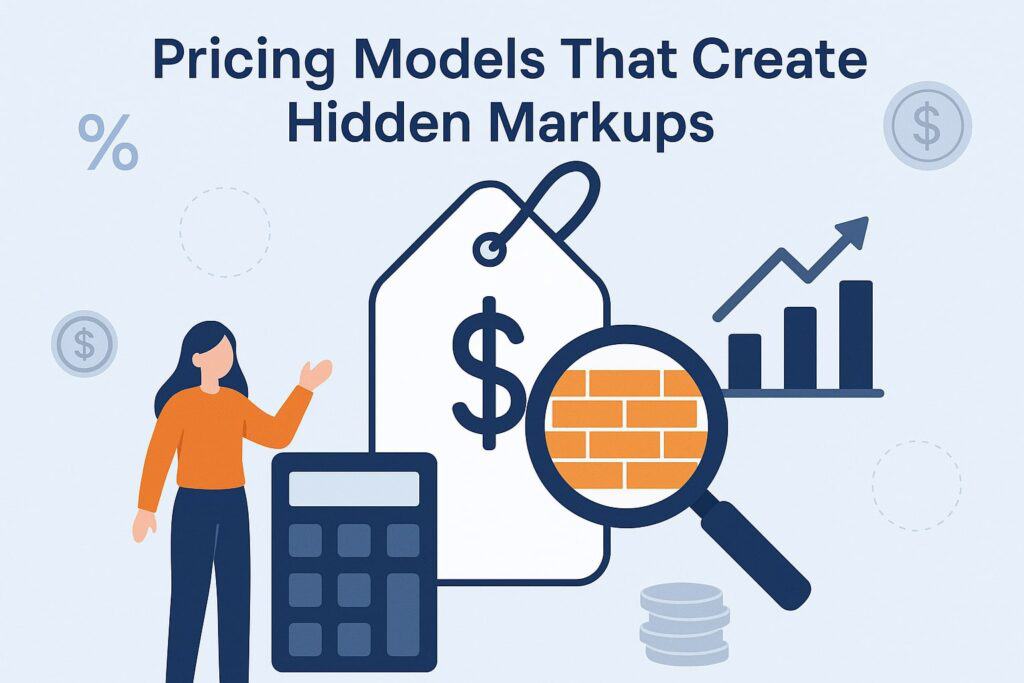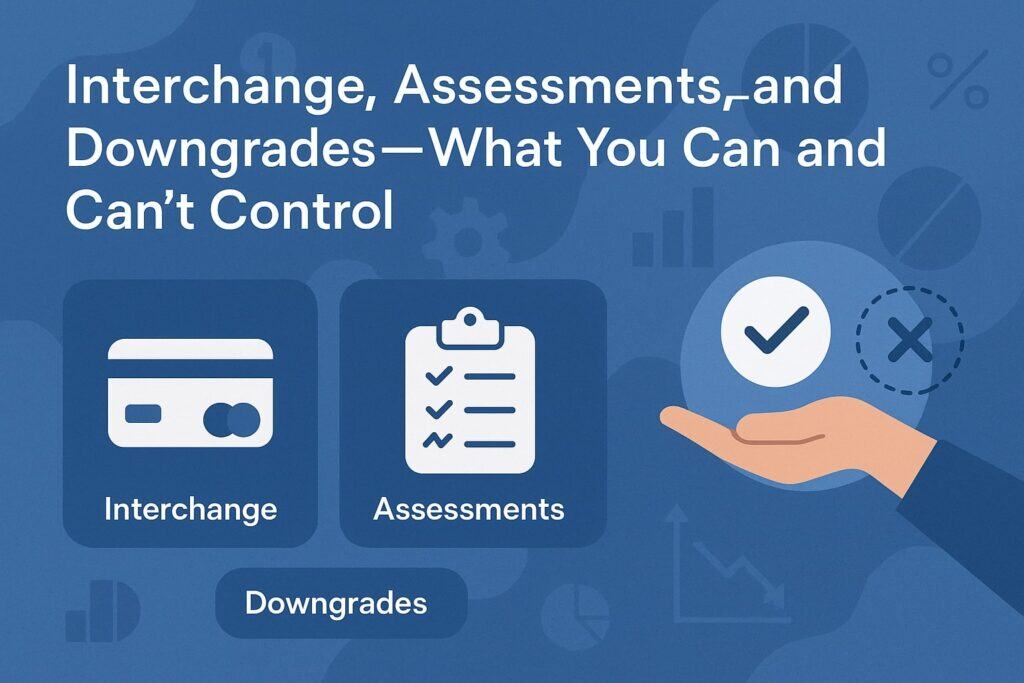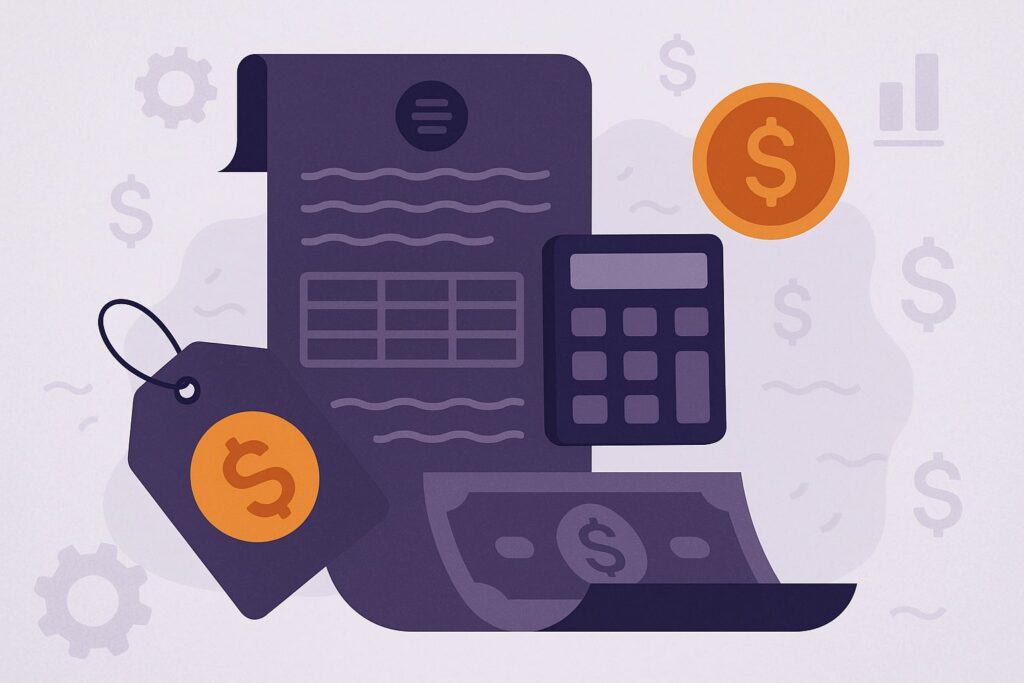
By pittsburgh-merchantservices October 17, 2025
Small businesses across the United States often pay more than they should for merchant services. The reasons are rarely about a single fee or one bad contract. Instead, overpayment comes from a maze of pricing models, padded markups, bundled software, and confusing statements.
When you accept credit cards, debit cards, and digital wallets, the real cost hides in the fine print and in how your provider structures your merchant services. This guide breaks down the moving parts in plain English, shows where the money leaks out, and gives you practical steps to lower expenses without disrupting sales.
You’ll learn how interchange works, why tiered pricing is risky, and which monthly fees add no value. We’ll also cover gateway costs, POS bundles, PCI fees, chargeback tools, and hardware leases.
Throughout, we’ll use clear US examples and compliance terms you’ll see on your merchant statement. If you run a cafe, HVAC company, boutique, e-commerce brand, or professional practice, these insights apply to your merchant services today.
The Real Cost Structure Behind Merchant Services

When you swipe, dip, tap, or key-enter a card, three layers determine your cost. The first layer is interchange, which is the wholesale fee set by card networks and paid to the card-issuing bank.
The second layer is card brand assessments, small network fees charged by Visa, Mastercard, American Express, and Discover.
The third layer is the acquirer or processor markup, which is where most small businesses overpay for merchant services. Your statement reflects all three, but only one is negotiable: the markup.
Interchange varies by card type, entry method, and risk signals. A consumer debit card run as a regulated PIN debit may cost far less than a rewards credit card keyed by hand. Assessments are typically fixed and relatively small.
The markup is where processors add basis points, per-transaction pennies, monthly platform fees, and “regulatory” costs that are not truly regulatory. If your merchant services plan is not on transparent interchange-plus or subscription pricing, it’s easy to pay more than necessary.
Another driver of overpayment is downgrades. Transactions that miss certain data elements or settle late can fall into more expensive interchange categories. If your POS is misconfigured, AVS isn’t used on keyed transactions, or you close batches inconsistently, you trigger downgrades that inflate costs.
The fix is operational discipline and good system setup, not paying a higher rate. By understanding these layers, you can evaluate any merchant services quote with more confidence and less guesswork.
Pricing Models That Create Hidden Markups

Most small businesses meet merchant services through three pricing models: tiered, flat-rate, and interchange-plus (including subscription or membership-style plans). Tiered pricing sorts transactions into “qualified,” “mid-qualified,” and “non-qualified” buckets with rates that look simple but hide substantial margins.
A chip-and-signature rewards card might fall into a higher tier even though its true cost isn’t much higher. Tiered statements also mask interchange and assessments, making it tough to audit your merchant services.
Flat-rate pricing sets one blended percentage and per-transaction amount for all cards. It simplifies budgeting and can be fair for very small tickets or variable volumes. But as your average ticket rises, or you take more debit, flat-rate pricing becomes expensive.
The provider pockets the difference between the wholesale cost and your flat price. Many US small businesses outgrow flat-rate merchant services without realizing it, leaving thousands of dollars on the table each year.
Interchange-plus is the most transparent model. You pay true interchange and assessments, plus a disclosed markup like “0.20% + $0.10” per transaction, and a modest monthly fee. The subscription version charges a flat monthly membership and tiny per-transaction pennies, minimizing percentage markups.
With either version, you can compare one merchant services offer to another using apples-to-apples math. The key is ensuring the markup is lean and that “junk fees” don’t quietly creep in later.
Interchange, Assessments, and Downgrades—What You Can and Can’t Control

A common misconception in merchant services is that the processor controls interchange. They do not. Interchange is set by the networks and paid to the issuing bank. Card brand assessments are also fixed.
What you can control is how your business qualifies transactions to hit the best available category. That means using chip or contactless wherever possible, capturing AVS on keyed entries, settling batches daily, and using level-2 or level-3 data for eligible B2B cards.
Downgrades happen when required data is missing or when the transaction doesn’t follow best practices. A keyed corporate card without tax and invoice fields might downgrade to a higher interchange rate.
Similarly, if your staff forgets to close the batch each night, those transactions can downgrade. These issues are common and costly in merchant services. The fix is simple training, clear procedures, and a POS configuration that prompts for the right data every time.
Merchants should also review refund timing and reversal practices. Late voids can turn into refunds that carry added fees. Partial approvals, split tenders, and manual key-in to “force” approvals introduce fraud risk and higher costs.
By aligning your checkout flow with the network’s preferred rails and data, your merchant services costs follow the path of least resistance. You cannot negotiate interchange, but you can avoid paying the most expensive versions of it.
Statement Complexity and Junk Fees That Inflate Costs

Merchant statements were not designed for clarity. Many providers rely on complexity to keep margins sticky. You might see PCI non-compliance fees, monthly statement fees, regulatory product fees, network access fees, batch fees, gateway fees, annual fees, and support fees—often layered on top of the processor’s markup.
Not every fee is illegitimate, but many are optional or duplicative. The result is small businesses paying too much for merchant services without a corresponding benefit.
A simple audit can uncover padded costs. Start by identifying which line items are set by card brands versus those invented by the provider. Assessments should be labeled clearly and track closely to published amounts.
If you see an amount that looks like a “brand fee” but changes month to month without reason, ask for documentation. Many “regulatory” or “compliance” charges are merely repackaged margin. A transparent merchant services plan keeps assessments separate and itemized.
Pay special attention to monthly minimums. A monthly minimum can make sense if your volume is tiny, but it should be modest and clearly applied. Some statements calculate the minimum in a way that disregards part of your paid fees, ensuring you owe extra.
Also review chargeback management line items—alerts and deflection tools are valuable for certain merchants, but not everyone needs them every month. If you don’t use the product, remove the fee. Clean statements lower the total cost of merchant services.
POS, Gateway, and Software Bundles: Convenience at a Cost
Modern POS systems and gateways are powerful, but bundling can trap you in high-cost merchant services. Providers often package the register, inventory, online ordering, invoicing, and analytics with their processing plan.
You get one bill and one support path, which feels convenient. The trade-off is that you may pay higher rates or accept hidden contract terms to access that software. If you ever want to switch processors, your POS may become useless or expensive to reconfigure.
To protect your margins, evaluate POS and gateway pricing on two tracks: software value and processing cost. Ask for a version of the agreement where software is priced transparently and processing is offered on interchange-plus with a clearly stated markup.
If the vendor refuses, that’s a red flag. In many cases, you can separate POS licensing from merchant services and keep leverage if rates drift upward. Open gateways and processor-agnostic POS platforms preserve your options.
For e-commerce, gateway fees often include a per-transaction cost plus a monthly platform fee. Some providers stack additional “tokenization,” “vault,” or “fraud tool” fees on top. Verify whether these are bundled or à la carte, and compare to third-party solutions.
If your volumes are growing, an open gateway with competitive merchant services can reduce blended costs while keeping your checkout fast and secure. The goal is to pay for software value once, not twice through inflated processing.
Hardware Leases and “Free” Equipment That Isn’t Free
Nothing drains merchant services value like a long hardware lease. Leasing a $300 countertop terminal for $49 a month over 48 months costs nearly $2,400 before taxes and fees. Leases are often non-cancelable, auto-renewing, and assigned to a separate finance company.
Even if you close your merchant account, the lease continues. Many small businesses end up paying for outdated hardware long after they switch processors, compounding overpayment for merchant services.
A better approach is to buy terminals outright or negotiate true loaner programs with simple return terms. If a provider advertises “free equipment,” read the fine print.
Often the agreement includes higher processing rates, early termination fees, or liquidated damages that dwarf the device’s value. Ask for the actual model and market price of the terminal. If the “free” hardware locks you into expensive merchant services, it isn’t free at all.
Consider device longevity and certification. EMV and contactless support are non-negotiable. Make sure your devices are certified with major US processors and can be reprogrammed if you switch.
For mobile and softPOS solutions, check whether the app works across iOS and Android and whether there are per-user license fees. Owning flexible hardware keeps your merchant services competitive because you can change providers without replacing your checkout.
Contract Traps: Early Termination, Liquidated Damages, and Auto-Renewals
Many merchant services contracts include early termination fees (ETFs) or, worse, liquidated damages based on estimated future profits. These clauses discourage switching even when rates creep up.
Some agreements auto-renew for multi-year terms unless you cancel during a narrow window. Others separate the processing agreement from the equipment lease, doubling the pain if you need to exit. This structure is common in the US and a major reason small businesses overpay for merchant services.
Protect yourself by demanding month-to-month terms or a short, cancel-anytime agreement. If a multi-year term is unavoidable, cap the ETF at a nominal flat amount and strike any liquidated damages language.
Keep a copy of the signed contract and calendar the renewal window. If your provider increases fees mid-term, ask for a written waiver of the ETF so you can switch. Simply knowing your rights and dates can save thousands in merchant services costs.
When reviewing contracts, look for rate change language that allows unilateral increases with 30 days’ notice. Also watch for clauses that allow the provider to pass through “new network fees” without proof.
Request that any pass-throughs be shown with network citations on your statement. By tightening the contract terms up front, you reduce the likelihood of future surprises and keep your merchant services accountable to performance and price.
PCI Compliance and Security Fees: Pay for Outcomes, Not Labels
PCI DSS compliance is essential, but many small businesses pay extra merchant services fees without improving security. Common charges include PCI program, non-compliance, SAQ assistance, quarterly scans, and breach protection.
Some are justified; others are inflated. If you complete your SAQ, use secure devices, and maintain good network hygiene, you should not be penalized monthly. Non-compliance fees are meant to push action, not act as a new revenue stream.
Ask your provider which PCI tasks are included and which are billed separately. If scans are required, confirm the cost and frequency. Validate whether “breach insurance” is meaningful or just a marketing term with limited coverage.
The most cost-effective path is to be compliant, document it, and ensure your PCI status is reported correctly to your merchant services provider. That eliminates recurring non-compliance penalties that quietly inflate your blended rate.
Also evaluate fraud tools on their merits. 3-D Secure, AVS, CVV checks, velocity rules, and tokenization all reduce risk when configured well.
Pay for tools that lower chargebacks or unlock better interchange categories, not for blanket packages you won’t use. Good security reduces both losses and disputes, which lowers the true total cost of merchant services beyond the line items you see on the statement.
Chargebacks and Dispute Tools: Where Fees Multiply Fast
Chargebacks cost more than the disputed transaction. You pay a chargeback fee, lose the sale amount temporarily, and spend time on documentation. Some providers add representation fees, case management fees, or alert subscription fees.
The right strategy is to prevent disputes before they start, and then handle the unavoidable cases efficiently. If your merchant services plan sells alerts or deflection tools, check whether your dispute mix justifies the spend.
Prevention starts with clear receipts, accurate descriptors, and prompt fulfillment. Use shipping confirmations with tracking for goods, and acceptance logs for services. For card-not-present sales, AVS and CVV checks reduce fraud.
If you run subscriptions, maintain a clean cancellation process and send renewal reminders. When disputes arise, respond within deadlines and include evidence that matches the reason code. Strong representation wins cases and discourages friendly fraud, lowering merchant services costs over time.
If you buy alerts, measure results. Alerts should intercept disputes and give you a chance to refund early. That only makes sense if the avoided chargebacks would have been lost anyway. Track the number of alerts, refunds issued, disputes avoided, and net savings.
Many small businesses pay for alert packages that don’t fit their profile. Tailor your merchant services toolkit to your actual risk, and you’ll keep both fees and losses under control.
Tiered vs. Flat-Rate vs. Interchange-Plus vs. Subscription
Choosing the right pricing model is the single most important decision for merchant services savings. Tiered pricing is simple on the surface but hides margins in the buckets.
You can’t easily audit it, and you’re at the provider’s mercy when transactions “downgrade” to expensive tiers. Flat-rate delivers predictability, which is helpful at very small volumes or micro-ticket environments, but it becomes costly as your average ticket and debit mix improve.
Interchange-plus is transparent and scalable. You pay true wholesale costs plus a disclosed markup, which can be compared across providers. If your business is growing, this model usually produces the lowest blended rate.
Subscription or membership pricing goes a step further by minimizing percentage markups and charging a monthly membership plus per-transaction pennies. For many US small businesses doing consistent volume, subscription merchant services offer the best long-run savings.
To choose well, analyze your mix: card-present vs. card-not-present, average ticket, debit share, rewards card share, and growth trajectory. Run a 3-month statement audit and model costs under each structure.
Do not forget fixed monthly fees, gateway costs, and extras like PCI programs. The best model is the one that lowers your total cost of acceptance while keeping your checkout smooth and compliant. That’s the heart of smarter merchant services.
Negotiation Playbook: How to Lower Your Merchant Services Costs
You have leverage, even as a small business. Start by requesting interchange-plus pricing with a modest markup, such as a small percentage and per-transaction penny amount, and a straightforward monthly fee.
Ask the provider to itemize assessments separately. Require month-to-month terms with no liquidated damages and a capped ETF if any. State clearly that you do not accept hardware leases, and that any equipment program must be returnable without penalty.
Next, present your three-month statement summary: total volume, number of transactions, average ticket, card-present mix, and debit share. Show your current effective rate, including all monthly fees, and ask the provider to beat it with a transparent proposal.
Request removal of non-essential fees like inflated PCI programs, statement fees, and redundant support charges. If you use a gateway or POS, negotiate software pricing separately from merchant services rates so you don’t pay twice.
Finally, ask for rate-lock language and notice requirements for any future changes. Keep email trails of every concession. If possible, obtain two competitive quotes and let providers know you’re comparing.
The goal is not to squeeze unsustainably but to align incentives. A fair, transparent merchant services plan with clean support saves you money and keeps your provider accountable. That is how you permanently stop overpaying.
How to Audit Your Statements and Calculate Your True Effective Rate
Auditing your merchant services is simpler than it looks. Step one: gather the last three statements. Step two: add up all costs—percentage fees, per-transaction fees, monthly charges, PCI fees, gateway fees, batch fees, and chargeback fees.
Step three: divide that total by your total processed volume. The result is your effective rate. This single number tells you what you truly paid to accept cards and digital wallets that month.
Next, review your average ticket and the share of debit versus credit. If you run many sub-$15 transactions or have high debit, flat-rate pricing can punish you with unnecessary percentage costs.
If you run higher-ticket B2B, you may qualify for level-2/level-3 interchange that your current setup misses. Look for downgrade indicators on the statement: terms like “non-qualified,” “std,” “ec”, or vague buckets imply you’re not seeing true interchange details in your merchant services.
Finally, scan for junk fees and compare assessments to known benchmarks. If an assessment looks inflated, ask for documentation. Check whether your monthly minimum is triggering and why.
Confirm that your PCI status is compliant, and remove non-compliance penalties. Document your findings in a simple spreadsheet. Bring that to any pricing conversation. When providers see you’ve measured your effective rate, they take your merchant services negotiation seriously.
When and How to Switch Providers Without Disruption
Switching merchant services feels risky, but the process can be smooth with planning. Start by decoupling POS and gateway from processing if possible. Export customer vaults securely and verify token portability.
Stage your new merchant account in parallel and process a small volume of test transactions. Confirm batch funding timelines, descriptor accuracy, and refund workflows. Once live, monitor the first week’s statements closely and reconcile deposits daily.
Communicate the change to your staff. Train cashiers and back-office teams on new prompts, settlement timing, and support contacts. If you use e-commerce, update API keys and webhooks in a controlled window.
Keep your old account open for a short overlap to handle late refunds and delayed chargebacks. This overlap prevents operational gaps and protects cash flow while your new merchant services settle into rhythm.
Finally, schedule a 30-day review to compare promised pricing to actual results. Validate that interchange-plus markups are correct, monthly fees match the quote, and any waived add-ons truly disappeared.
If something drifts, escalate immediately. A clean cutover and a disciplined first month ensure your switch delivers the savings you sought, and you stop overpaying for merchant services long term.
Emerging Payment Methods and Compliance Considerations in the US
The merchant services landscape keeps evolving. Contactless cards, mobile wallets, and pay-by-link options are now table stakes. Account-to-account payments, RTP-enabled invoicing, and digital invoicing with surcharge or cash-discount logic are gaining adoption.
Before enabling a new method, verify the card brand rules, state regulations, and tax implications. Surcharging, for example, must follow network caps and disclosure rules, and compliance varies by jurisdiction. Always align your checkout with US requirements and your processor’s policies.
Tokenization and network token rails reduce fraud and can improve authorization rates. For subscription businesses, dunning tools and account updater services keep card credentials current, lowering involuntary churn.
In B2B, level-2 and level-3 data can materially reduce interchange if your invoicing and POS capture the right fields. Each of these enhancements should be measured against their cost so you only pay for merchant services that drive clear ROI.
As you adopt new methods, maintain clear customer communication. Display accepted payments, refund timelines, and dispute steps on receipts and policy pages. Keep descriptors consistent and recognizable.
Make it easy to reach support. These simple practices lower disputes, improve approvals, and align your merchant services with a professional brand experience that saves money and builds loyalty.
Practical Checklist to Stop Overpaying for Merchant Services
- Move to interchange-plus or subscription pricing with fully itemized assessments.
- Eliminate hardware leases; own flexible EMV/contactless devices.
- Demand month-to-month terms; strike liquidated damages and cap any ETF.
- Separate POS/gateway licensing from processing rates to retain leverage.
- Complete PCI on time; remove non-compliance and duplicate “program” charges.
- Configure POS for AVS, daily batching, and level-2/3 fields where eligible.
- Audit for junk fees quarterly; compare assessments to published ranges.
- Track your effective rate and average ticket; re-quote annually with competitors.
- Right-size chargeback tools; pay only for what reduces real losses.
- Maintain descriptor clarity and refund discipline to prevent disputes.
This checklist keeps your merchant services lean, transparent, and adaptable as your business grows. It turns a confusing cost center into a controllable operating expense you can forecast and optimize.
FAQs
Q.1: Why is tiered pricing usually more expensive for small businesses?
Answer: Tiered pricing sorts transactions into buckets with opaque criteria. Providers control which transactions land in higher-priced tiers, and statements hide true interchange.
That structure often overcharges compared to interchange-plus, where the merchant services markup is fixed and visible. As your mix shifts toward debit or chip transactions, tiered buckets rarely pass through those savings.
Q.2:Is flat-rate ever the right choice?
Answer: Flat-rate merchant services can be fine for very small volumes or micro-ticket businesses that value simplicity over precision.
It keeps budgeting easy and straightforward. But once your volume or average ticket grows, the blended rate tends to exceed interchange-plus. If you’re processing steadily, run the math. Flat-rate convenience may be costing you real money.
Q.3: What’s a reasonable markup on interchange-plus?
Answer: There isn’t a one-size-fits-all answer, but the principle is consistency and clarity. A modest percentage plus per-transaction pennies, combined with a fair monthly fee, is typical.
The best merchant services proposals show assessments separately, keep add-ons minimal, and avoid shifting rates later. Always compare the total effective rate, not just the headline markup.
Q.4: How can I tell if I’m being charged junk fees?
Answer: Look for vague items like “regulatory product fee,” inflated PCI programs, or statement fees with no service attached. Compare brand assessments against published norms and ask your provider to document any pass-throughs.
If a fee cannot be explained in writing, it’s likely a margin. Transparent merchant services avoid ambiguous labels entirely.
Q.5: Do I need chargeback alerts?
Answer: It depends on your dispute profile. If you process card-not-present sales with a history of friendly fraud, alerts can prevent costly chargebacks. If disputes are rare, alert subscriptions may not pay for themselves. Measure avoided losses against alert costs. Tailor your merchant services tools to your actual risk, not a one-size-fits-all package.
Q.6: Should I upgrade my terminals to save on fees?
Answer: Yes, if your current devices lack EMV/contactless or cause downgrades. Modern, certified hardware reduces fraud and improves data capture, helping you avoid higher interchange categories.
Owning flexible devices that can be reprogrammed also keeps your merchant services competitive if you change providers.
Q.7: Can I negotiate out of a long contract?
Answer: Sometimes. If fees increase mid-term or service levels slip, you can request a waiver of the ETF and liquidated damages. Document issues and escalate. For your next agreement, insist on month-to-month merchant services and avoid leases so you never need to negotiate your way out again.
Q.8: What’s the fastest way to lower my effective rate?
Answer: Shift to interchange-plus, remove junk fees, ensure PCI compliance, and fix operational issues like daily batching and AVS. These steps attack the biggest drivers of overpayment in merchant services. Combine them with a competitive re-quote, and you should see immediate savings.
Conclusion
Overpaying for merchant services isn’t inevitable. It’s the product of opaque pricing, layered fees, and contracts designed to reduce your choices. By understanding interchange, scrutinizing assessments, and demanding transparent markups, you reclaim control over a critical operating cost.
Separate POS value from processing, avoid leases, complete PCI on time, and right-size dispute tools. Measure your effective rate quarterly and keep providers honest with documented comparisons.
Small improvements compound. A cleaner statement, a fairer markup, and better transaction data can add up to thousands of dollars per year for a US small business.
With the knowledge in this guide, you can replace confusing merchant services with a simple, scalable plan that supports growth. The money you save becomes cash you can reinvest in marketing, staffing, and customer experience—the parts of your business that truly create value.